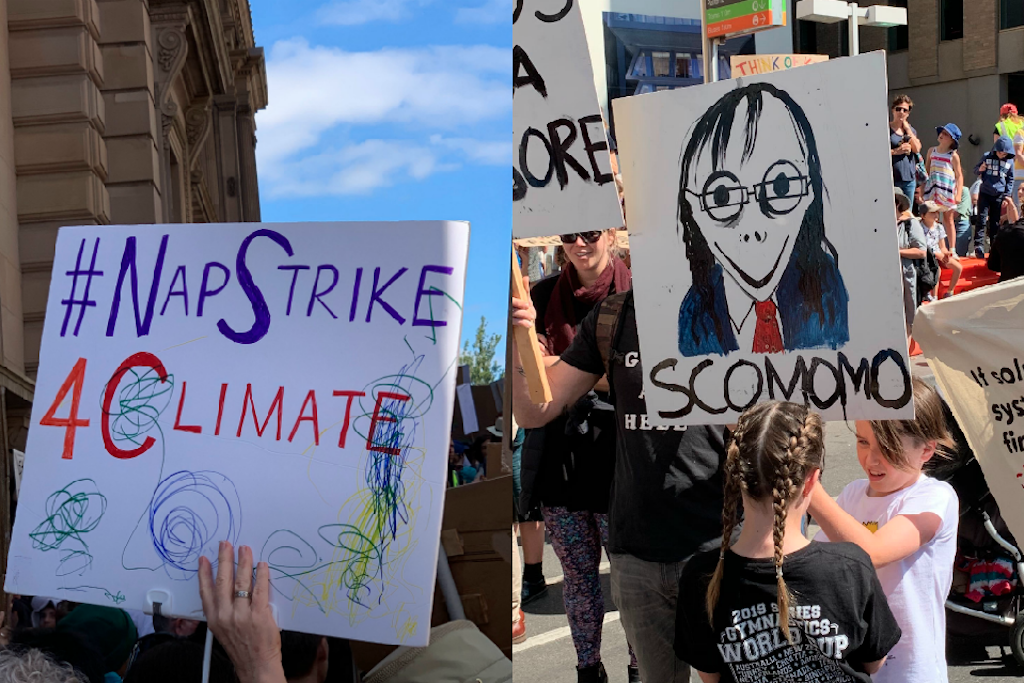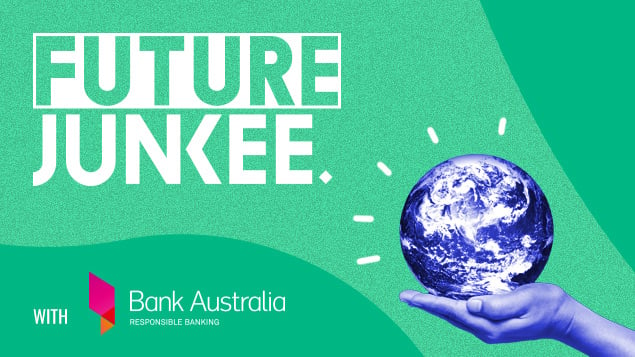‘2040’ Will Give You Hope About Our Planet, Even Under This Government
"There is a bit of a nihilistic narrative that is emerging around people... I think that is really dangerous."

Early into 2040, Australian director Damon Gameau’s latest documentary, he assures the audience this isn’t the regular doom-and-gloom look at climate change. Instead, it’s an “exercise in fact-based dreaming”; and if that phrasing makes you roll your eyes, you’re not alone. Even Gameau was sceptical, at first.
“I definitely did not go in to it optimistic,” Gameau tells me over the phone. “I went in to it feeling really overwhelmed and not knowing how I was going to communicate this stuff to my daughter and feeling really paralysed by the constant negative storytelling that was out there.”
“I still have moments of [pessimism] even now, but when you spend three years deeply immersed meeting these people that really passionately care about the future and are doing things to try and solve the problem, you can’t help but feel optimistic.”
After the success of 2014 doco That Sugar Film, Gameau embarked on a three-year (and carbon neutral) quest around the globe. The film is presented as an open letter to his now four-year-old daughter, Velvet, as 2040 tries to answer the question many young parents have: what sort of world will my kids live in, and how will we make it better?
That last part is central. 2040‘s ‘fact-based dreaming’ is the CGI-heavy future Gameau creates in scenes picturing a grown-up Velvet living in a green-utopia — and while the realities might look a little too cinematographer-led at times, the tools behind them are very much possible.
All the tech on display exists now — for Gameau, it was important that 2040‘s solutions must be here, even if the support isn’t. Despite its optimistic tone, the film isn’t escapism; it’s combatting how climate change is, frankly, an utterly depressing topic.
“I just think people are so swamped with negative stories,” he says, “that to go and watch [a typical climate change doco] after a day at work would be the last thing you would want to see. I feel that particularly with the climate, we have really diagnosed the problems incredibly well — and it is bad news… but I guess it is about trying to show things that we can fight for, instead of fighting against.”
“Scientists have a problem with communicating,” he says. “They’ve done a brilliant job of dissecting the problem, but they need help to communicate them in ways that we can connect to it on a human level… [We need] writers to help out and try and reinterpret somebody’s language in a way that is going to motivate people and really try to get them to understand it.”
“We always want to help, we always want a vision for a better world. That’s what motivates us. That belief that things can get better. So, I just thought it was an opportunity to try to tell a story in a slightly different way.”
What Could 2040 Look Like?
Talk of clean energy and conscious consumption go a long way, but 2040 moves beyond carbon neutrality and explains the importance of carbon sequestering — undoing the damage we’ve done.
Beyond those you likely know (increased share transport, plant-centred diets, renewable energy), there are several lesser-known technologies in use across the world. There’s seven major solutions 2040 proposes for our future, and Gameau tells me one of the most interesting parts of screening it has been how audiences tell him the moment where they lost their cynicism.
For me, it was towards the film’s end, which Gameau affectionally calls the “seaweed solution”.
“What I didn’t put in the film was just the staggering amount of carbon that seaweed can [sequester]. It just felt too good to be true.”
Brown seaweed is the fastest growing plant in the world, with the capacity to grow half a metre a day. By creating ‘farms’ of seaweed in the ocean on a bed of recycled plastic, they can absorb a frankly ridiculous amount of carbon — and over time, sink under their own weight towards the seabed, where the carbon will be successfully sequestered by the weight of the ocean floor.
In addition, it helps restore the ocean’s ecosystem, is incredibly resilient. It can also be farmed, and used as food for both humans and livestock; the Intrepid Foundation (who just confirmed with the University Of Tasmania Australia’s first trial farm, just off Bruny Island) estimates that if less than 1 percent of livestock feed became sea-weed, we could reduce cattle emissions by 60 percent.
“What I didn’t put in the film was just the staggering amount of carbon that seaweed can [sequester],” he says. “It just felt too good to be true. But if you put [on] somewhere between 4 and 5 percent of the oceans between California and Australia, these large marine permacultures — if you build these giant forests out at sea, they sequester all of our current emissions.”
Learning about this was Gameau’s own ‘a-ha’ moment, too.
“When you spend three years deeply immersed, meeting these people that really passionately care about the future and are doing the things to try and solve the problem, you can’t help but feel optimistic,” he says. “I certainly loved the seaweed solution, that was probably the moment that I rang my wife and said we can do it.”
But Australia Just Re-elected The Coalition…
Gameau acknowledges there’s big barriers to many solutions. Some are cultural (how will we give up the autonomy of having our own cars?), some economic, some political — many, all three.
Visiting India, 2040 shows off solar panel grids currently in place in 25 villages across India and Bangladesh. Through a cheap, easily installable box, houses can sell and share their own solar panel’s juice with their neighbours. Tests are underway in Australia, but, as the process essentially decentralises electricity, it makes for a hard sell with many governments — and vetted interests
“I think people got scared, that were nervous about the change, that bought into the ‘fear narrative’, and I don’t think it is an indication that they don’t care.”
Unfortunately, it’s difficult to see how such a radical idea could be implemented on a national level, especially under the Morrison government, whose re-election came the week of the film’s release.
Chatting, Gameau doesn’t shy away from the elephant in the room — that the Australian public elected a government that refuses to act on climate change, and, with the opening of the Adani mine, is actively heading in the wrong direction.
“These solutions can provide security, they can reduce inequality. they can strengthen communities… that got lost. I think people got scared, that were nervous about the change, that bought into the ‘fear narrative’, and I don’t think it is an indication that they don’t care.”
“I just think it’s really important that we show a message in a much better way… I don’t think that was clear enough, and that was something that was nagging me, three weeks ago. I thought, ‘well there is a big danger here’, because, especially in Queensland, people aren’t getting the right message here. They’re starting to think that they are going to lose their money, their livelihoods. That was a failure.”
But What About The Farmers?
2040 centres agriculture as a solution to climate change, not an obstacle.
With regenerative, more traditional practices (where farmers tend to a variety of non-crop plants to bring in carbon to their soil, and allow livestock to graze), farmers can benefit too. Some in Australia, as 2040 shows, already are.
“Even farmers who are very conservative and are still dubious on climate, they are doing [regenerative] practices because they understand how damaged their soils are,” he says.
Unfortunately, that’s not the government’s leading message, but there still ways to lead our leaders.
“Yes, it would be great if we could get the government to really help them and fund that transition, but [in the meantime] if one person just donates $8 a month [via Carbon 8], you can sequester 1200 tonnes of carbon in a year, which offsets the omissions of 80 people who do nothing.”
“We need to get on with it, show this is what we are passionate about, get enough people involved and send the signal to our leaders, saying ‘this is how we can do it, this is how we can help farmers, look at the benefits they yield, look how they are involved’. We just have to hope that then the leaders come on board.”
“Whether [they] do is the challenge. That’s the hardest thing we have got to orchestrate, but I think it is really important for people to know that it is possible.”
“I think that story is starting to fade a little bit — there is a bit of a nihilistic narrative that is emerging around people, and there is a bit of a doom and gloom and ‘oh, we can’t do this stuff this year’. I think that is really dangerous, especially for kids. [But] I do think we can do it now.”
2040 is in Australian cinemas now. On opening weekend (May 25, 26), any child can see the film for free at Palace Cinema if they attend with a paying adult.
Jared Richards is a staff writer at Junkee, and co-host of Sleepless In Sydney. Follow him on Twitter.


